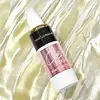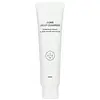What's inside
What's inside
 Key Ingredients
Key Ingredients

 Benefits
Benefits

 Concerns
Concerns

 Ingredients Side-by-side
Ingredients Side-by-side

Camellia Sinensis Leaf Water
MaskingWater
Skin ConditioningGlycerin
HumectantCoco-Betaine
CleansingMethyl Gluceth-10
EmulsifyingEthoxydiglycol
HumectantDipropylene Glycol
HumectantMethylpropanediol
SolventSodium Chloride
MaskingButoxydiglycol
MaskingDiglycerin
HumectantGlycereth-26
HumectantXanthan Gum
EmulsifyingCamellia Sinensis Leaf Powder
ExfoliatingQuillaja Saponaria Bark Extract
CleansingPrunus Amygdalus Dulcis Oil
Skin ConditioningAvena Sativa Kernel Extract
AbrasiveDiethoxydiglycol
SolventCoco-Glucoside
CleansingCaprylyl Glycol
EmollientGlyceryl Caprylate
EmollientDecyl Glucoside
CleansingPentylene Glycol
Skin Conditioning1,2-Hexanediol
Skin ConditioningSodium Cocoyl Isethionate
CleansingButylene Glycol
HumectantOctanediol
Panthenol
Skin ConditioningCitric Acid
BufferingEthylhexylglycerin
Skin ConditioningCaprylic/Capric Triglyceride
MaskingSodium PCA
HumectantDisodium EDTA
Camellia Sinensis Leaf Water, Water, Glycerin, Coco-Betaine, Methyl Gluceth-10, Ethoxydiglycol, Dipropylene Glycol, Methylpropanediol, Sodium Chloride, Butoxydiglycol, Diglycerin, Glycereth-26, Xanthan Gum, Camellia Sinensis Leaf Powder, Quillaja Saponaria Bark Extract, Prunus Amygdalus Dulcis Oil, Avena Sativa Kernel Extract, Diethoxydiglycol, Coco-Glucoside, Caprylyl Glycol, Glyceryl Caprylate, Decyl Glucoside, Pentylene Glycol, 1,2-Hexanediol, Sodium Cocoyl Isethionate, Butylene Glycol, Octanediol, Panthenol, Citric Acid, Ethylhexylglycerin, Caprylic/Capric Triglyceride, Sodium PCA, Disodium EDTA
Water
Skin ConditioningCocamidopropyl Betaine
CleansingMethyl Gluceth-10
EmulsifyingEthoxydiglycol
HumectantDipropylene Glycol
HumectantButoxydiglycol
MaskingDiglycerin
HumectantGlycereth-26
HumectantDiethoxydiglycol
SolventGlycerin
HumectantButylene Glycol
HumectantPEG-7 Glyceryl Cocoate
EmulsifyingXanthan Gum
EmulsifyingPhenoxyethanol
PreservativeCaprylyl Glycol
EmollientParfum
MaskingDisodium EDTA
Cocos Nucifera Oil
MaskingHoney Extract
HumectantDecyl Glucoside
CleansingRoyal Jelly Extract
Skin ConditioningSapindus Mukorossi Fruit Extract
Skin ConditioningSaponaria Officinalis Leaf Extract
AntimicrobialMaltodextrin
AbsorbentMoringa Oleifera Seed Extract
Skin ConditioningPropolis Extract
Skin ConditioningWater, Cocamidopropyl Betaine, Methyl Gluceth-10, Ethoxydiglycol, Dipropylene Glycol, Butoxydiglycol, Diglycerin, Glycereth-26, Diethoxydiglycol, Glycerin, Butylene Glycol, PEG-7 Glyceryl Cocoate, Xanthan Gum, Phenoxyethanol, Caprylyl Glycol, Parfum, Disodium EDTA, Cocos Nucifera Oil, Honey Extract, Decyl Glucoside, Royal Jelly Extract, Sapindus Mukorossi Fruit Extract, Saponaria Officinalis Leaf Extract, Maltodextrin, Moringa Oleifera Seed Extract, Propolis Extract
Ingredients Explained
These ingredients are found in both products.
Ingredients higher up in an ingredient list are typically present in a larger amount.
We don't have a description for Butoxydiglycol yet.
Butylene Glycol (or BG) is used within cosmetic products for a few different reasons:
Overall, Butylene Glycol is a safe and well-rounded ingredient that works well with other ingredients.
Though this ingredient works well with most skin types, some people with sensitive skin may experience a reaction such as allergic rashes, closed comedones, or itchiness.
Learn more about Butylene GlycolCaprylyl Glycol is a humectant and emollient, meaning it attracts and preserves moisture.
It is a common ingredient in many products, especially those designed to hydrate skin. The primary benefits are retaining moisture, skin softening, and promoting a healthy skin barrier.
Though Caprylyl Glycol is an alcohol derived from fatty acids, it is not the kind that can dry out skin.
This ingredient is also used as a preservative to extend the life of products. It has slight antimicrobial properties.
Learn more about Caprylyl GlycolDecyl Glucoside is a glucose-based surfactant and emulsion stabilizer. It is created by reacting glucose with the fatty acids from plants.
Surfactants help clean the skin by trapping oil, sebum, and dirt to be washed away. As an emulsion stabilizer, it stabilizes the ingredients in a product by preventing them from separating.
This ingredient is biodegradable and non-toxic. This ingredient is commonly found in baby shampoos.
Decyl Glucoside is sometimes used to stabilize the UV filter Tinosorb.
Learn more about Decyl GlucosideWe don't have a description for Diethoxydiglycol yet.
Diglycerin is a humectant. It is derived from glycerin, which is naturally found in your skin.
As a humectant, it helps draw moisture to the skin from the air.
Dipropylene Glycol is a synthetically created humectant, stabilizer, and solvent.
This ingredient helps:
Dipropylene glycol is technically an alcohol, but it belongs to the glycol family (often considered part of the ‘good’ alcohols). This means it is hydrating and gentle on skin unlike drying solvent alcohols like denatured alcohol.
As a masking agent, Dipropylene Glycol can be used to cover the smell of other ingredients. However, it does not have a scent.
Studies show Dipropylene Glycol is considered safe to use in skincare.
Learn more about Dipropylene GlycolDisodium EDTA plays a role in making products more stable by aiding other preservatives.
It is a chelating agent, meaning it neutralizes metal ions that may be found in a product.
Disodium EDTA is a salt of edetic acid and is found to be safe in cosmetic ingredients.
Learn more about Disodium EDTAEthoxydiglycol is a synthetic solvent.
Solvents are used to keep ingredients together in a product. They can help dissolve ingredients to stable bases or help evenly distribute ingredients throughout the product.
Ethoxydiglycol also helps deliver other key ingredients into the skin.
Learn more about EthoxydiglycolGlycereth-26 is a synthetic ingredient and polyethylene glycol ether of Glycerin. Glycerin is already naturally found in your skin and helps keep your skin moisturized.
It is a humectant and helps add texture to products. It can make your product thicker.
As a humectant, it helps draw moisture from the air to your skin. This helps your skin stay hydrated.
Learn more about Glycereth-26Glycerin is already naturally found in your skin. It helps moisturize and protect your skin.
A study from 2016 found glycerin to be more effective as a humectant than AHAs and hyaluronic acid.
As a humectant, it helps the skin stay hydrated by pulling moisture to your skin. The low molecular weight of glycerin allows it to pull moisture into the deeper layers of your skin.
Hydrated skin improves your skin barrier; Your skin barrier helps protect against irritants and bacteria.
Glycerin has also been found to have antimicrobial and antiviral properties. Due to these properties, glycerin is often used in wound and burn treatments.
In cosmetics, glycerin is usually derived from plants such as soybean or palm. However, it can also be sourced from animals, such as tallow or animal fat.
This ingredient is organic, colorless, odorless, and non-toxic.
Glycerin is the name for this ingredient in American English. British English uses Glycerol/Glycerine.
Learn more about GlycerinWe don't have a description for Methyl Gluceth-10 yet.
Water. It's the most common cosmetic ingredient of all. You'll usually see it at the top of ingredient lists, meaning that it makes up the largest part of the product.
So why is it so popular? Water most often acts as a solvent - this means that it helps dissolve other ingredients into the formulation.
You'll also recognize water as that liquid we all need to stay alive. If you see this, drink a glass of water. Stay hydrated!
Learn more about WaterXanthan gum is used as a stabilizer and thickener within cosmetic products. It helps give products a sticky, thick feeling - preventing them from being too runny.
On the technical side of things, xanthan gum is a polysaccharide - a combination consisting of multiple sugar molecules bonded together.
Xanthan gum is a pretty common and great ingredient. It is a natural, non-toxic, non-irritating ingredient that is also commonly used in food products.
Learn more about Xanthan Gum